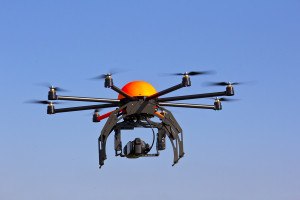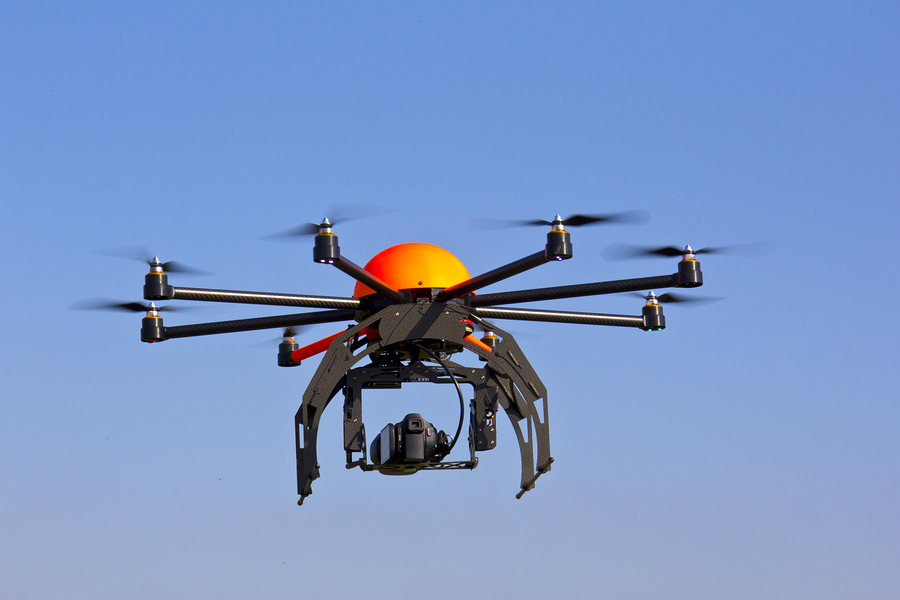It is only the tip of the iceberg. As technology advances, common citizens are increasingly finding themselves with the ability to obtain and fly reasonably-priced unmanned aerial vehicles (UAVs) known as drones. News broadcasts are only now beginning to reflect the growing problems we can anticipate as their use becomes more and more common, both privately and commercially. Armed with high-definition cameras, these civilian UAVs have ranges of up to several miles and can hover over a neighbor’s pool party and capture footage of activity engaged in with an expectation of privacy. The typical quadcopter has a flight time of 15 minutes, although smaller ones with tiny Photron FASTCAM viewer (FPV) cameras might be able to manage as much as 30 minutes. The proliferation of these amazing devices brings with it a whole host of legal issues which most assuredly will give rise to civil disputes and litigation. Understanding the laws affecting their use now becomes a prerequisite as opposed to an opportunity for an interesting lunch conversation.
 Congress has charged the Federal Aviation Administration (FAA) with the responsibility for setting rules and regulations regarding the operation of drones. On February 15, 2015, the FAA released its Notice of Proposed Rulemaking (NPRM) for small unmanned aircraft. This is the first step in changing regulations and rules currently in place. Right now, however, federal, state, and local laws are in flux, and do not adequately govern the rights of citizens either operating drones or being victimized by them. In Pittsburgh, a drone flew over a professional baseball game. In Los Angeles, hockey fans entering a sports arena successfully knocked a harassing drone out of the sky. A Seattle woman observed a drone outside her high-rise window videotaping her as she dressed. In Nashville, a drone interfered with a July 4th fireworks display. In all of these instances, it is unclear whether the drone operators could be held criminally or civilly liable simply for flying their drones over private property. There exists a great deal of controversy regarding even the FAA’s authority to govern their usage. While it has the ability to prevent drone use near airports, but whether it has the same authority elsewhere remains in dispute.
Congress has charged the Federal Aviation Administration (FAA) with the responsibility for setting rules and regulations regarding the operation of drones. On February 15, 2015, the FAA released its Notice of Proposed Rulemaking (NPRM) for small unmanned aircraft. This is the first step in changing regulations and rules currently in place. Right now, however, federal, state, and local laws are in flux, and do not adequately govern the rights of citizens either operating drones or being victimized by them. In Pittsburgh, a drone flew over a professional baseball game. In Los Angeles, hockey fans entering a sports arena successfully knocked a harassing drone out of the sky. A Seattle woman observed a drone outside her high-rise window videotaping her as she dressed. In Nashville, a drone interfered with a July 4th fireworks display. In all of these instances, it is unclear whether the drone operators could be held criminally or civilly liable simply for flying their drones over private property. There exists a great deal of controversy regarding even the FAA’s authority to govern their usage. While it has the ability to prevent drone use near airports, but whether it has the same authority elsewhere remains in dispute.
The right of a landowner to control the low-altitude space immediately over his private property appears to be in conflict with the right of a drone owner to operate a drone in the same airspace. Prior to the Wright Brothers, 19th Century law followed the Latin maxim, Cujus est solum, ejus est usque ad coelum (“To whomever the soil belongs, he also owns the sky”). After the dawn of aviation, however, Congress passed the Air Commerce Act of 1926 and the Civil Aeronautics Act of 1938, authorizing flight within “navigable airspace” – airspace later defined to be over 500 feet above ground level. In 1946, the U.S. Supreme Court confirmed that a landowner has a right to prevent “intrusions of airspace” just as he does invasions on the ground, and that he owned “at least as much of the space above the ground as he can occupy or use in connection with the land.” U.S. v. Causby, 328 U.S. 256 (1946). It held that government flights which were so low and frequent as to interfere with the enjoyment of the land constituted a “taking.” It did not, however, clarify how much of the space below the 500-foot FAA ceiling belonged to the landowner. However, conflicts between landowners and air travelers were fairly uncommon. The proliferation of ultra-light aircraft over the past decade has exacerbated the issue somewhat, but, with the growth of drone use, it is clear that the debate has been reignited and will need to be addressed formally.
In as much as today’s laws provide no definite ceiling on a landowner’s airspace, whether and where drones may and may not fly, remains uncertain. Is a flight 100 feet above private property allowable? What about 10 feet? When does it become trespass? The U.S. Supreme Court has already told us that a pilot’s naked-eye surveillance of private property below is legal and does not constitute an invasion of privacy. California v. Ciraolo, 476 U.S. 207 (1986). This open airspace is simply a “public vantage point” which the government, law enforcement, or a private citizen can observe from above. Helicopters are not required to stay above the 500-foot navigable airspace floor, so the Supreme Court tells us that their observation from as low as 400 feet is legal. Florida v. Riley, 488 U.S. 445 (1989).
Another possible approach to the regulation of drones is to apply laws dealing with invasion of privacy. As stated in the Restatement (Second) of Torts § 159(2):
Flight by aircraft in the air space above the land of another is a trespass if, but only if, (a) it enters into the immediate reaches of the air space next to the land, and (b) it interferes substantially with the other’s use and enjoyment of his land. Restatement (Second) of Torts § 159(2).
However, this approach is very subjective and burdensome, requiring courts to weigh the competing interests of the parties on a case-by-case basis. More is needed.
In addition to FAA rules, state and local governments are scrambling to pass ordinances governing the use of drones. While the FAA has exclusive jurisdiction to regulate the airspace above 500 feet, states can also regulate the airspace at lower altitudes. At least 43 states have pending legislation to regulate drone use. The FAA is primarily concerned with flight safety. However, states are more concerned with privacy and nuisance issues. Alabama, for example, recently passed a law which prohibits the use of a drone to harass a hunter or fisherman. California passed a law last year prohibiting anybody using a drone from taking a picture of a person who has an “expectation of privacy.” Colorado prohibits drones from being used in aiding hunters. Montana law limits the admissibility of evidence in a civil or criminal legal proceeding if it was obtained using UAVs. Tennessee makes it a misdemeanor to use drone-captured video footage of a hunter or angler without their consent. Texas passed an omnibus bill that identifies 19 lawful uses for drones – a bill criticized by some as opening the door for police abuse. In Wisconsin, weaponizing a drone is a felony and law enforcement must obtain a warrant before using one to collect evidence.
Drone use may seem like something out of a science fiction movie, but they are here to stay, together with all of the interesting legal issues and conundrums they create. With the onset of commercial drone use, over-regulating their private use may solve some problems while at the same time tying the hands of businesses, small and large, and stifling innovation. One thing remains certain. With the proliferation of drone use U.S. courts and legislators will be faced with the same challenges regarding low-altitude airspace as they were faced with regarding high-altitude airspace when modern aviation was born.
Was this article valuable?
Here are more articles you may enjoy.



 NYC Tourist Helicopter Crashes in Hudson River, Killing Six
NYC Tourist Helicopter Crashes in Hudson River, Killing Six  Roof Repair and Replacement Costs up Nearly 30% Since 2022, Report Shows
Roof Repair and Replacement Costs up Nearly 30% Since 2022, Report Shows  Jack Dorsey’s Block to Pay New York $40 Million in Cash App Settlement
Jack Dorsey’s Block to Pay New York $40 Million in Cash App Settlement  Group Sues California Department of Insurance Over FAIR Plan Surcharges
Group Sues California Department of Insurance Over FAIR Plan Surcharges 